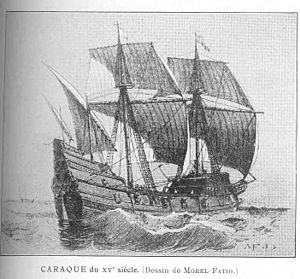San Esteban (1554 shipwreck)

San Esteban was a carrack, a common sailing vessel of the time.
|
|
| History | |
|---|---|
|
|
|
| Name: | San Esteban |
| Struck: | 29 April 1554 |
| Fate: | Wrecked |
| General characteristics | |
| Class and type: | Carrack |
| Tons burthen: | 164 to 286 long tons (167 to 291 t) |
| Length: | 21 to 30 metres (69 to 98 ft) |
San Esteban was a Spanish cargo ship that was wrecked in a storm in the Gulf of Mexico on what is now the Padre Island National Seashore in southern Texas on 29 April 1554.
San Esteban was one of a flotilla of four ships carrying treasure from New Spain (Mexico) to Cuba. Three were wrecked in the storm, including San Esteban. Many of the three hundred sailors and passengers drowned while trying to reach shore. About thirty took a boat to seek help. Almost all the others died of thirst or starvation, or were killed by hostile local Karankawa Indians during their attempt to walk back to safety. The Spanish sent a salvage expedition, but recovered less than half of the cargo and treasure.
One of the wrecks was rediscovered in 1964. A private company, Platoro, Ltd., began to excavate the Espíritu Santo wreck in late 1967, which caused public outrage and the passage of new laws to protect wrecks on the Texan coast. The remains of San Esteban were found in 1970 and excavated in 1972-73. Many artifacts have been recovered and are held in the Corpus Christi Museum of Science and History. They include the world's oldest mariner's astrolabe with a confirmed date.
San Esteban left Sanlúcar de Barrameda, Spain, on 4 November 1552. It was part of a fleet of 54 ships under the command of Captain-General Bartolomé Carreño that included an escort of six well-armed ships with 360 soldiers. The escorting ships and 18 vessels were destined for the mainland of South America. Ten ships were heading to Santo Domingo and four to other parts of the West Indies. Sixteen were bound for San Juan de Ulúa (Veracruz) in New Spain (Mexico).
The fleet had a difficult outbound voyage, suffering from bad weather, accidents and skirmishes with pirates. Eight vessels were lost and the rest scattered. All the New Spain flotilla arrived safely at Vera Cruz during February and March 1553. The plan was to scrap eleven of the vessels and keep only five to make the return journey. This was typical. Ships from the Americas to Spain carried a much smaller volume of cargo than ships traveling in the other direction, although the shipments to Spain included valuable gold and silver.
...
Wikipedia
